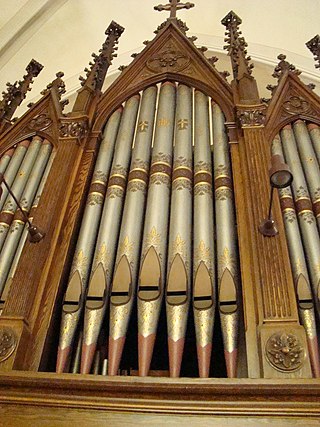
The Lutheran Church – Missouri Synod (LCMS), also known as the Missouri Synod, is a traditional, confessional Lutheran denomination in the United States. With 1.8 million members, it is the second-largest Lutheran body in the United States, behind the Evangelical Lutheran Church in America. The LCMS was organized in 1847 at a meeting in Chicago, Illinois, as the German Evangelical Lutheran Synod of Missouri, Ohio, and Other States, a name which partially reflected the geographic locations of the founding congregations.

The Wisconsin Evangelical Lutheran Synod (WELS), also referred to simply as the Wisconsin Synod, is an American Confessional Lutheran denomination of Christianity. Characterized as theologically conservative, it was founded in 1850 in Milwaukee, Wisconsin.

The Evangelical Lutheran Synodical Conference of North America, often known simply as the Synodical Conference, was an association of Lutheran synods that professed a complete adherence to the Lutheran Confessions and doctrinal unity with each other. Founded in 1872, its membership fluctuated as various synods joined and left it. Due to doctrinal disagreements with the Lutheran Church–Missouri Synod (LCMS), the Evangelical Lutheran Synod (ELS) and the Wisconsin Evangelical Lutheran Synod (WELS) left the conference in 1963. It was dissolved in 1967 and the other remaining member, the Synod of Evangelical Lutheran Churches, merged into the LCMS in 1971.

St. Stephen Lutheran Church, or Iglesia Luterana San Esteban, is a designated Milwaukee Landmark. It is in the historic Walker's Point district of Milwaukee, Wisconsin.
The Wangerin Organ Company (1912-1942) was a manufacturer of pipe organs based in Milwaukee, Wisconsin. It was a continuation of the company after the partnership of Adolph Wangerin and George J. Weickhardt, Wangerin-Weickhardt, ended with the death of Weickhardt in 1919. It had previously also been known as the Hann-Wangerin-Weickhardt company. Many of its organs are still played in churches today.

The Schuelke Organ Company was a Milwaukee, Wisconsin-based pipe organ builder. Schuelke Organs operated in the later 19th and early 20th centuries.

Christ Evangelical Lutheran Church is a historic church built in 1901 by a German Lutheran congregation southwest of the Walker's Point neighborhood of Milwaukee, Wisconsin. It is listed on the National Register of Historic Places.

St. John's Evangelical Lutheran Church is a Gothic Revival-styled church built in 1889 in Milwaukee, Wisconsin by a congregation with German roots. In 1992, the church and associated buildings were listed on the National Register of Historic Places. It is also designated a Milwaukee Landmark.

Saint Paul's Evangelical Lutheran Church is a congregation in the Indiana District of the Lutheran Church–Missouri Synod (LCMS) located at the intersection of Barr and Madison Streets in Fort Wayne, Indiana. Founded in 1837, it is the second oldest Lutheran church in Indiana and the oldest in the northern part of the state. Thanks largely to its size and to the leadership of its pastors, it has long played a prominent role in Indiana Lutheranism and in the LCMS as a whole.

The Indiana District is one of the 35 districts of the Lutheran Church – Missouri Synod (LCMS), encompassing the state of Indiana and most of western Kentucky; the remainder of Kentucky is divided between the Mid-South District and the Ohio District. However, one Kentucky congregation and ten Indiana congregations are in the non-geographic English District, and two congregations in Lake County are in the SELC District. The Indiana District is home to Concordia Theological Seminary in Fort Wayne, Indiana, and includes approximately 236 congregations and missions, subdivided into 24 circuits, as well as 53 preschools, 49 elementary schools, and 3 high schools. Baptized membership in district congregations is approximately 102,000.

St. Peter's Evangelical Lutheran Church, or Iglesia Luterana San Pedro, is a historic church complex located in the Walker's Point neighborhood of Milwaukee, Wisconsin. Its buildings are listed on the National Register of Historic Places.

St. John's Evangelical Lutheran Church is an historic Lutheran church located in Corning, Missouri. It was founded as a Confessional Church, adhering to the Unaltered Augsburg Confession. It later became a member of the Lutheran Church–Missouri Synod (LCMS).

The Historic Trinity Lutheran Church is a church located in downtown Detroit, Michigan. It occupies the Trinity Evangelical Lutheran Church complex, located at 1345 Gratiot Avenue. It was designated a Michigan State Historic Site in 1981 and listed on the National Register of Historic Places in 1983. Its current pastor is Rev. Darryl L. Andrzejewski.

Zion Lutheran Church is a historic Lutheran church located along Prospect Avenue near downtown Cleveland, Ohio, United States. Formed in the 1840s, the congregation built the present building shortly after 1900, along with an adjacent church school. Both buildings have been named historic sites. The school is no longer open.

St. Paul Lutheran Church is located in central, Davenport, Iowa, United States. It is affiliated with the Evangelical Lutheran Church in America (ELCA). The church's original property, which subsequently housed other Protestant congregations, was listed on the National Register of Historic Places in 1983, but has since been torn down. The present complex was built in 1952 and contains two buildings that are contributing properties in the Vander Veer Park Historic District. The present church building was completed in 2007.
India Evangelical Lutheran Church (IELC) is a Christian denomination in India. Its headquarters is in Tamil Nadu. It belongs to the International Lutheran Council and the Lutheran World Federation. It has three synods, named Ambur Synod, Nagercoil Synod, and Trivandrum Synod. The IELC was founded through the missionary efforts of the Lutheran Church–Missouri Synod (LCMS), with whom it remains in altar and pulpit fellowship.

Augustana Lutheran Church is an Evangelical Lutheran Church in America congregation located in Sioux City, Iowa, United States. The church building was listed on the National Register of Historic Places in 2006 as Swedish Evangelical Lutheran Augustana Church.

Trinity Lutheran Church is a member congregation of the Lutheran Church–Missouri Synod (LCMS) in Altenburg, Missouri.
The following is a timeline of significant events in the history of the Lutheran Church – Missouri Synod.



















